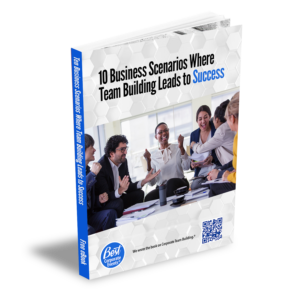Every organization wants to build high-performing teams. But too often, leadership efforts focus on myths or misconceptions about how to achieve high performance. This post exposes some of those myths, sets the record straight, and provides practical research-based guidance.
Following his 2021 Harvard Business Review article, 5 Things High-Performing Teams Do Differently, leadership consultant and author Ron Friedman, Ph.D., shared six more secrets of high-performing teams, based on new research, in a series of newsletter articles early this year.
Among other findings, three of the most significant common myths that Friedman dispatched were:
The highest performing teams work together in a single location.
Wrong.
Friedman’s team found no correlation between workplace structure (in the office, remote, or hybrid) and team performance.
That’s not surprising, and tracks with other recent research. As noted here previously, it’s not where employees work but how they work that matters. Engagement is the key factor in high performance, not physical proximity.
As we noted, “Study after study identifies flexibility as one the most critical factors for increasing employee engagement.” It improves work-life balance and reduces stress.
Leadership also plays a crucial role. Workers are much more likely to report high levels of engagement if their manager shows trust, empowers them, and takes initiative in helping with their career advancement.
Finally, team building is valuable. While not every employee wants to be in the office—at least not full time—most employees enjoy solving problems collaboratively, expanding their own skills, and building relationships with coworkers. All of those activities enhance engagement, and team building includes all of those elements.
You can tell how well a team functions by the number of disagreements its members have.
False.
According to Friedman’s findings, “The number of disagreements a team experiences is entirely unrelated to its level of performance…How disagreements are handled is vastly more important than the total number of disagreements.”
Disagreements on work teams are actually a good thing, in many cases. They indicate that people are engaged in the problems or challenges facing the group, that they are bringing up new ideas, and that they are comfortable challenging one another.
The key is to work through and resolve those disagreements in a productive, healthy manner. A number of specific team building and professional development programs can teach and build these skills, such as:
Conflict Resolution Training: Effectively managing conflict is key to turning situations with the potential to create animosity in the workplace into productive exchanges of ideas. Using the results of the Thomas Kilmann Inventory Assessment, the facilitator shows how natural conflict-handling styles can be refined and how to implement approaches that will build a culture better equipped to productively channel conflict.
DiSC Profile Workshop: The DiSC Model helps professionals understand their communication style and improve the success of their teams. Participants learn how to manage styles, eliminate bad habits, and minimize conflict. The DiSC assessment team building workshop is designed to evoke self-discovery and explore behavioral styles across four dimensions.
Myers-Briggs Type Indicator (MBTI) Training: This enlightening workshop introduces the Myers-Briggs Type Indicator (MBTI) assessment to enhance team dynamics. By understanding individual personality types, participants learn how to improve group communication, understanding, and performance. The training empowers teams with a common language and tools to unlock individual potential, leveraging their diverse personalities to increase productivity and reduce conflict.
Emotional Intelligence Training: Emotional Intelligence (E.I.) helps employees understand and manage emotions while contributing to their fullest potential in the organization. In this thought-provoking workshop, participants explore the power of E.I. to create a culture of trust, exceptional internal customer loyalty, and open communication.
Igniting Team Performance Series™: Newly formed groups can benefit from the Igniting Team Performance training program that emphasizes interactive collaboration, challenges, and conflict resolution. For teams that already work well together, Igniting Team Performance offers a challenging set of exercises to test and enhance their leadership, communication, meeting management, and goal-setting abilities.
The best way to collaboratively solve problems is to meet in a conference room with a white board.
Nope.
While that may be standard operating procedure in many organizations, and white boards are indeed helpful for capturing ideas, Friedman reported:
“Here’s another fascinating finding from our new study on high-performing teams: their leaders take significantly more walking meetings. Why might walking meetings benefit team performance? Researchers have long known that walking helps stimulate creativity and problem-solving, both by getting more blood flowing to the brain, and exposing us to new stimuli as we talk through our challenges…(and) beyond higher-quality thinking, walking meetings also foster stronger relationships.”
Walking meetings aren’t appropriate in every situation, of course, and for team exercises, the outdoors aren’t always great. New stimuli can spark ideas, but can also be a distraction. And the weather isn’t always conducive to productive discussions.
That said, getting outdoors and getting active can be a great way to build relationships and promote collaborative problem solving—especially as a break from a series of conference room meetings.
It’s why corporate scavenger hunts are so popular (and productive). They are a great way to explore a new city, as at annual corporate or sales kickoff meetings. They also help build trust, communication, and creative problem solving as teams race against each other to conquer challenges and complete the route. And they’re fun.
Best Corporate Events and our sister company, SmartHunts, offer a variety of different types of hunts to meet different objectives, from our Amazing Chase SmartHunt® and City SmartHunt® which are great for exploring new places, to our Escape SmartHunt® (a twist on escape rooms, with exciting challenges) and our Locate and Donate SmartHunt®, which combines the excitement of a scavenger hunt with the satisfaction of giving back to the local community.
In Conclusion
What are the secrets of high-performing teams? Many of the findings from recent research are surprising and even counterintuitive.
Distractions aren’t always bad. Speed often matters more than precision. Engagement is far more important than physical proximity. Disagreements can be positive (if managed properly). Sometimes the best idea is to take a walk.
Team building and professional development programs can be very helpful in terms of fostering engagement, managing conflict, and getting out of the office to build relationships and solve problems.
One final point: making team building a habit is another secret to building and maintaining high-performing teams. As noted, “Top-performing organizations make team building a regular event, often running programs several times each year…A regular cadence of team building exercises helps develop a culture of high performance.”


